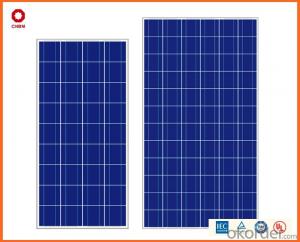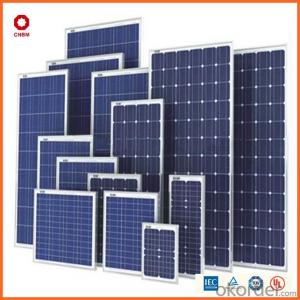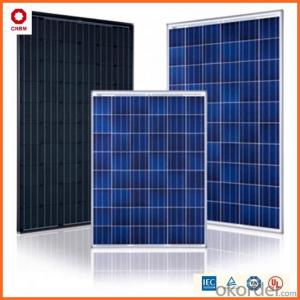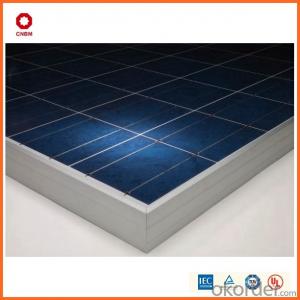305w Poly Solar Panel 0.45/W A Grade Good Solar Panel on Sale
- Loading Port:
- China main port
- Payment Terms:
- TT OR LC
- Min Order Qty:
- 1 watt
- Supply Capability:
- 10000000 watt/month
OKorder Service Pledge
OKorder Financial Service
You Might Also Like
Item specifice
Product Description:
Hot Sale !!! Quality and Safety of 245w-320w Poly Solar Panel
1. Rigorous quality control meets the highest international standards.
2. High-transmissivity low-iron tempered glass, strong aluminium frame.
3. Using UV-resistant silicon.
4. IS09001/14001/CE/TUV/UL
Warranties of 245w-320w Poly Solar Panel
1. 10 years limited product warranty
2. 15 years at 90% of the minimal rated power output
3. 25 years at 80% of the minimal rated power output
Specification
Characteristics of Poly solar panels CNBM (245-320W) | |||||
Max Power Voltage Vmp(V) | 30.3 | 30.8 | 31.1 | 31.4 | 31.85 |
Max Power Current Imp(A) | 7.60 | 7.64 | 7.73 | 7.81 | 7.85 |
Open Circuit Voltage Voc(V) | 36.1 | 36.6 | 37 | 37.3 | 37.68 |
Short Circuit Current Isc(A) | 8.50 | 8.55 | 8.65 | 8.75 | 8.85 |
Max Power Pm(W) | 230W | 235W | 240W | 245W | 250W |
Temperature Coefficient of Cells Poly solar panels CNBM (245-320W) | |
NOCT | 45 ± 2 |
Temperature Coeffucients of Isc | 0.0492 |
Temperature Coeffucients of Voc | -0.3374 |
Temperature Coeffucients of Voc | -0.4677 |
Mechanical Data of Poly solar panels CNBM (245-320W) | |
Dimension | 1638 × 982 × 40 mm |
Weight | 19.5 kg |
No. of Cells and Connections | 60 (6 ×10) |
Tolerance | 0 ~ + 5 W |
Cell | Monocrystalline Cell 156 × 156 mm |
Packing | 624 Pcs/40ft(H) Container |
Limits of Poly solar panels CNBM (245-320W) | |
Operating Temperature | -40 to +85 |
Storage Temperature | -40 to +85 |
Max System Voltage | 1000VDC(IEC) / 600VDC(UL) |
Features of our products:
• High conversion efficiency mono/poly-crystalline amorphous silicon solar cells
• Modules incorporate high performance bypass diodes to minimize the power drop caused by shading
• High transmittance, low-iron tempered glass
• High performance EVA encapsulant to prevent destroying and water.
• AI frame: without screw, corner connection. 8 holes on the frame can be installed easily
• Good performance of preventing from atrocious weather such as wind and hails
• Certifications: CE IEC TUV VDE UL, Class I
• 10 years 90% power output warranty

Shipping of 245w-320w Poly Solar Panel
By Sea | Delivery from Shanghai or Ningbo seaport |
By Air | Departure from Shanghai Pudong Airport |
By Express | Post by DHL, EMS, UPS, TNT. |
- Q:Can solar energy systems be used for space cooling?
- Yes, solar energy systems can be used for space cooling. Solar-powered air conditioning systems are designed to absorb sunlight and convert it into electrical energy to power the cooling process. These systems typically use solar panels to generate electricity, which is then used to run the air conditioning unit. By utilizing solar energy, these systems offer a sustainable and energy-efficient solution for space cooling.
- Q:Can solar energy systems be used for water heating?
- Yes, solar energy systems can be used for water heating. Solar water heating systems use the sun's energy to heat water, which can then be used for various purposes such as bathing, cooking, or space heating. These systems typically consist of solar collectors, which absorb sunlight and convert it into heat, and a storage tank to store the heated water. Solar water heating is a sustainable and cost-effective way to meet the hot water demand in residential, commercial, and industrial settings.
- Q:Can a solar energy system be used for charging electric vehicles?
- Yes, a solar energy system can definitely be used for charging electric vehicles. Solar panels, which capture sunlight and convert it into electricity, can be installed on rooftops, carports, or open spaces to generate clean and renewable energy. This energy can then be used to charge electric vehicles, eliminating the need for traditional fossil fuel-based charging methods. Solar-powered charging stations are becoming increasingly popular and are being installed in various locations, such as parking lots, highways, and residential areas, to support the growing demand for electric vehicles. By utilizing solar energy for charging electric vehicles, we can significantly reduce greenhouse gas emissions and dependence on non-renewable energy sources, thus contributing to a more sustainable and environmentally friendly transportation system.
- Q:How do solar energy systems handle excess energy production?
- Solar energy systems handle excess energy production through a process called net metering. When the solar panels produce more electricity than needed, the excess energy is fed back into the grid, and the solar system owner receives credits for the surplus electricity. These credits can then be used to offset the electricity consumed from the grid during periods of low solar energy production, such as at night or during cloudy days.
- Q:Can solar energy systems be used in powering green hotels or eco-resorts?
- Yes, solar energy systems can definitely be used in powering green hotels or eco-resorts. Solar power is a clean and renewable source of energy that can greatly contribute to reducing the carbon footprint of these establishments. By installing solar panels on the roofs or open spaces of hotels and resorts, they can generate electricity from the sun's rays and use it to power their operations. Solar energy systems can provide a significant portion, if not all, of the electricity needed to run a green hotel or eco-resort. This includes powering lighting systems, heating and cooling systems, water pumps, and other electrical appliances. The excess energy generated during the day can also be stored in batteries or fed back into the grid to be used during nighttime or low sunlight periods. Implementing solar power in these establishments not only helps reduce their dependence on fossil fuels but also makes them more self-sufficient and resilient to power outages. It aligns with their commitment to sustainability and eco-conscious practices, attracting environmentally conscious travelers who prioritize staying in green accommodations. Furthermore, solar energy systems can also enhance the overall guest experience at these hotels and resorts. They can provide opportunities for educational tours and demonstrations where guests can learn about the benefits of solar power and the importance of renewable energy sources. This can create awareness and inspire guests to adopt sustainable practices in their own lives. In conclusion, solar energy systems are an excellent choice for powering green hotels or eco-resorts. They offer a clean, renewable, and reliable source of electricity that aligns with their sustainability goals. By harnessing the power of the sun, these establishments can reduce their carbon footprint, enhance their guest experience, and contribute to a more sustainable future.
- Q:What is the role of inverters in solar energy systems?
- The role of inverters in solar energy systems is to convert the direct current (DC) electricity generated by the solar panels into alternating current (AC) electricity, which can be used to power homes, businesses, and other electrical appliances. Inverters also ensure that the AC electricity produced matches the frequency and voltage requirements of the electrical grid, enabling seamless integration and distribution of solar power.
- Q:Can solar energy systems be used for agricultural applications?
- Yes, solar energy systems can be used for agricultural applications. Solar panels can be used to power various agricultural operations such as irrigation systems, water pumps, and electric fences. Additionally, solar energy can be used in greenhouses to provide heating, lighting, and ventilation. Overall, utilizing solar energy in agriculture can help reduce reliance on traditional energy sources and contribute to sustainable farming practices.
- Q:What is the role of a solar energy system installer?
- The role of a solar energy system installer is to design, install, and maintain solar energy systems for residential, commercial, and industrial buildings. They play a crucial role in the transition towards renewable energy sources and are responsible for ensuring that solar panels are properly installed and functioning efficiently. Firstly, a solar energy system installer evaluates the site where the solar panels will be installed. They assess factors such as the location, orientation, and shading of the site to determine the optimal design and placement of the panels. This involves conducting a thorough analysis of the site's solar potential and considering any potential obstacles that may affect the system's performance. Once the design is finalized, the installer procures the necessary equipment and materials required for the installation. This includes solar panels, inverters, mounting systems, and electrical components. They also ensure compliance with local building codes and regulations. The installation process involves mounting the solar panels on rooftops or on the ground, connecting them to the electrical system of the building, and wiring them to the inverters. Installers must have a strong understanding of electrical systems to ensure safe and efficient connection of the solar panels. After the installation, solar energy system installers conduct thorough testing and commissioning to ensure that the system is functioning properly. This includes checking the electrical connections, monitoring system performance, and troubleshooting any issues that may arise. In addition to installation, solar energy system installers are also responsible for providing maintenance and repair services. They perform regular inspections, clean the panels, and replace any damaged or faulty components to ensure optimal performance and longevity of the system. They may also assist with system upgrades or expansions as needed. Overall, the role of a solar energy system installer is crucial in promoting the adoption of renewable energy. They are responsible for the successful installation and maintenance of solar energy systems, enabling individuals and businesses to reduce their reliance on fossil fuels and contribute to a more sustainable future.
- Q:Are there any disadvantages to installing a solar energy system?
- Yes, there are a few disadvantages to installing a solar energy system. Some of the main drawbacks include the high upfront cost of installation, the need for sufficient sunlight to generate optimal power, and the requirement for ample space to accommodate the solar panels. Additionally, solar energy systems can be less efficient during cloudy or rainy periods, and their production may not align with peak energy demands. Finally, the maintenance and occasional replacement of components can be costly and time-consuming. Despite these disadvantages, the long-term benefits and environmental advantages of solar energy make it an increasingly popular and viable option for many households and businesses.
- Q:How does the efficiency of solar panels vary across different panel sizes?
- Solar panels can have varying efficiency across different sizes due to multiple factors. Typically, larger panels exhibit higher efficiency compared to smaller ones. This is primarily because larger panels possess a greater surface area for capturing sunlight, thereby enabling them to generate more electricity. Larger solar panels have the capacity to accommodate more solar cells, responsible for converting sunlight into electricity. These additional cells augment the overall power output of the panel, resulting in increased efficiency. Furthermore, larger panels often possess better current and voltage ratings, allowing them to produce more electricity even in low light conditions. However, it is important to note that the size of solar panels does not solely determine their efficiency. The overall quality and technology of the panel also play a significant role. Manufacturers may employ different levels of technological advancements, materials, and manufacturing processes, all of which can affect the efficiency of their panels. Moreover, external factors such as temperature, shading, and installation angle can influence the efficiency of solar panels. Higher temperatures can reduce their efficiency, while shading from trees or buildings can significantly hinder performance. Additionally, the installation angle of the panels can impact their exposure to sunlight, thereby affecting overall efficiency. In conclusion, while larger solar panels generally exhibit higher efficiency due to their larger surface area and increased power output, other factors such as panel quality, external conditions, and installation angle can also influence efficiency across different sizes. It is imperative to consider all these factors when selecting the appropriate panel size for a specific application to ensure optimal performance and energy generation.
1. Manufacturer Overview |
|
|---|---|
| Location | |
| Year Established | |
| Annual Output Value | |
| Main Markets | |
| Company Certifications | |
2. Manufacturer Certificates |
|
|---|---|
| a) Certification Name | |
| Range | |
| Reference | |
| Validity Period | |
3. Manufacturer Capability |
|
|---|---|
| a)Trade Capacity | |
| Nearest Port | |
| Export Percentage | |
| No.of Employees in Trade Department | |
| Language Spoken: | |
| b)Factory Information | |
| Factory Size: | |
| No. of Production Lines | |
| Contract Manufacturing | |
| Product Price Range | |
Send your message to us
305w Poly Solar Panel 0.45/W A Grade Good Solar Panel on Sale
- Loading Port:
- China main port
- Payment Terms:
- TT OR LC
- Min Order Qty:
- 1 watt
- Supply Capability:
- 10000000 watt/month
OKorder Service Pledge
OKorder Financial Service
Similar products
New products
Hot products
Related keywords






























